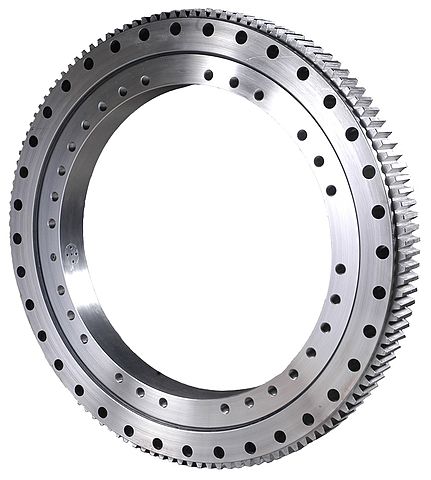How Does a Slew Ring Work?

Slew rings have a few different names, including turntable bearings, slewing rings and slewing bearings.
The purpose of slewing rings is to enable rotational motion between different components in a system (Ritbearing). That motion can be radial, axial or tilting.
Slewing rings can be made of a variety of rigid materials such as carbon steel, chrome steel, stainless steel, brass, plastic and/or anodized aluminum. They can range in diameter from a few inches to over three metres wide. They are usually used for heavy loads (up to just over 2.5 tonnes of static load capacity) on slow applications.
Applications for slewing rings are quite varied. They include wind power, packaging machinery, robotics, cranes, drilling and mining as well as satellite equipment.
How does a slew ring work and what are its component parts?
Two concentric rings make up the main structure of a slewing bearing. The outer ring usually lies flat against a motionless surface and is screwed into place via evenly spaced mounting holes. The inner ring is usually affixed to a turning object via an adapter plate or bracket. It usually moves in a rotational manner while the outer ring stays affixed to the mounting surface.
Relative rotation between rings is facilitated either by rolling or sliding elements. For slewing rings that operate with ball bearings, parts that facilitate greasing of the system are included, such as seals, load plugs, grease fittings and taper pins. For slewing rings that are based on sliding elements, replaceable plastic liners lie between the inner and outer rings.
Because slewing rings based on ball bearings have very small contact points (ball bearings touching the inner and outer ring surfaces), they are able to move with very low friction.
Slewing rings that are based on plastic liners to facilitate movement (with a larger inner ring surface to better handle heavier loads) work better for flat, horizontal applications . Vertical applications are better suited for ball bearing-based slewing rings.
Both slewing ring types can include gears on the outer ring OD or the inner ring ID to facilitate different application requirements.
The different ways to drive a slewing ring include:
- External gear
- External belt
- Worm gear
- Drive-plate coupling
Electrical Insulation
One distinct advantage of a slewing ring using plastic liners is that it is electrically insulating. That is, cables can run through the center of the slewing without requiring any additional layer of polymer or any other form of grounding. Slewing rings based on ball bearings, in contrast, require an additional layer of polymer or some form of grounding in order to prevent electricity from traveling through the slewing ring from the cables.
Conclusion
Now that you have learned how a slewing ring functions, you are welcome to learn more about the different kinds of slewing rings igus offers or go to our shop to explore our low-cost variations. igus makes engineered wear plastics that have the benefits of zero maintenance and self-lubrication.
References:
https://commons.wikimedia.org/wiki/File:Slewing_bearing.jpg
https://www.silverthin.com/bearings/slewing-rings/engineering/components.php
https://www.ritbearing.com/products/slewing-ring-bearings/
https://www.kaydonbearings.com/downloads/whitepapers/Kaydon-GearedSlewingRingsWP.pdf



